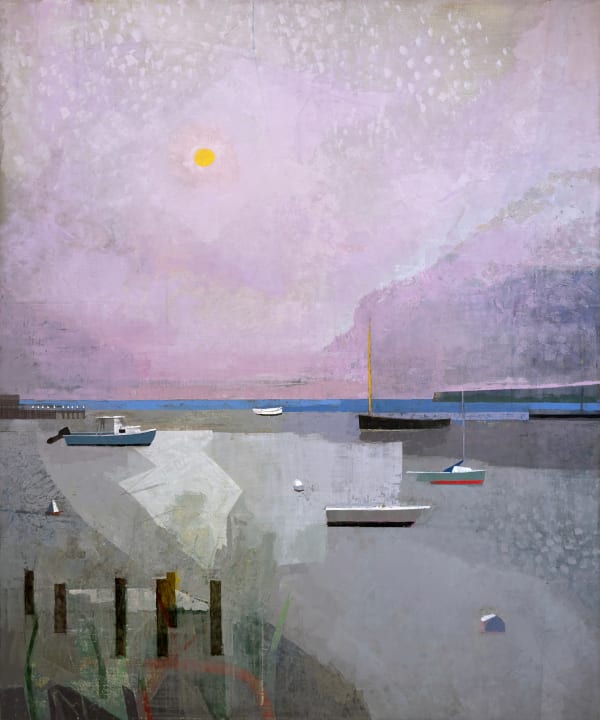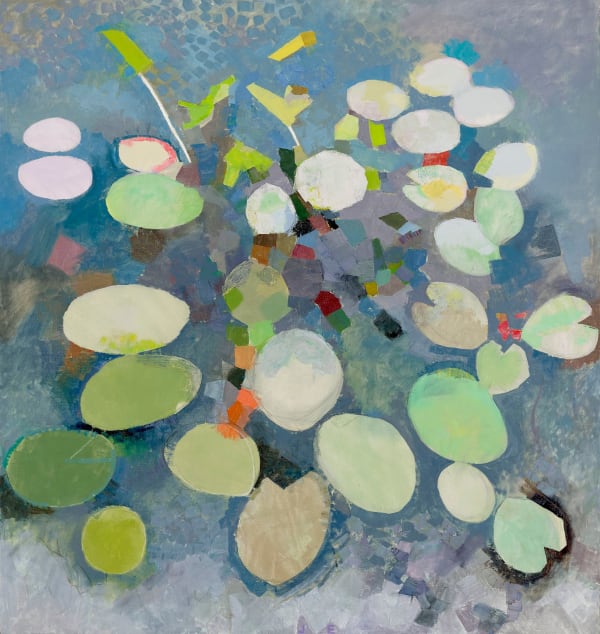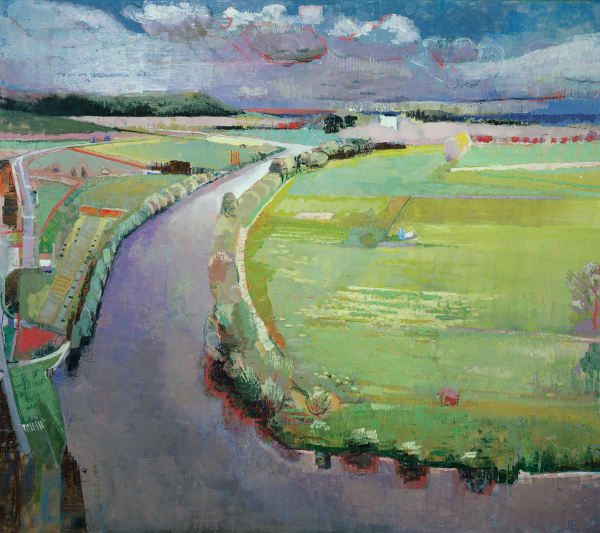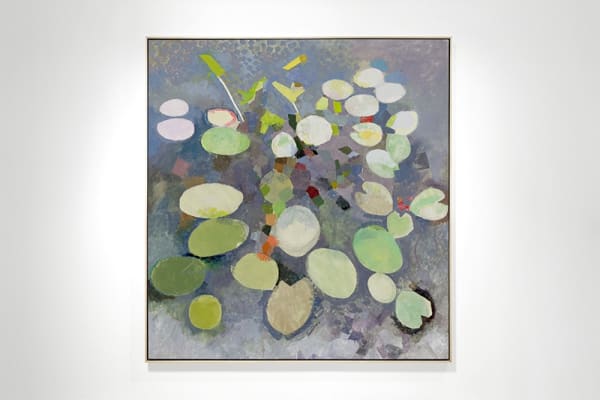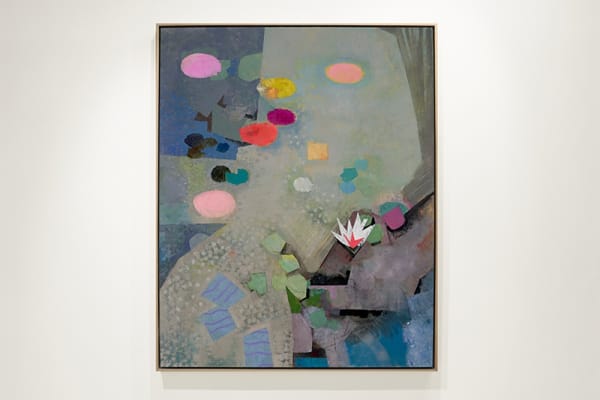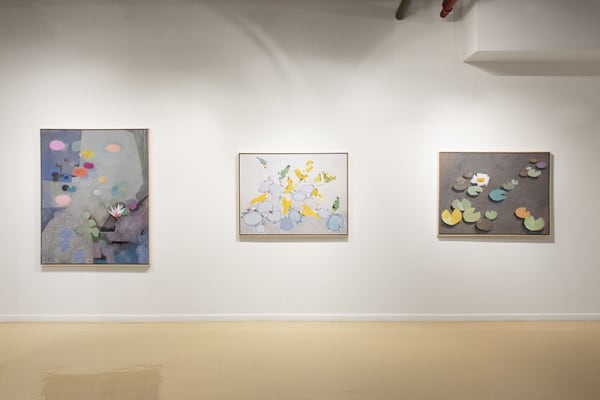Breathing: John Evans
It’s evident when looking at John Evans’ work that he is a painter completely enveloped in the process of painting. As one approaches his work, it becomes less about identification or subject, and more about a medium on a surface. Scratches, pencil marks, palette knife scrapes and drawing all take place, revealing and concealing, with the intention of servicing the respective forms as the picture is made. There are layers of underpainting that appear to live on top of other colors, rather than beneath. He allows the initial ground to exist closer to the viewer, thus assigning it more importance. Upon closer inspection, these initial graphite traces allude to a map of sorts, with the moment of inception occurring just before the hiker goes off the trail. For this new body of work on view at Gallery Henoch, Evans has revisited a botanical theme that originally inspired him following a visit to a garden in Palm Beach. A few of his photographs have become the reference for an entire body of work. This transformative landscape is one that he moves with and becomes part of through the physical gestures as they interact with the surface of a canvas.
Waterlilies, a common visual trope in this body of work, float across the painted surfaces. At times they resemble hearts, at other moments they become simple ellipses, then still forms, only existing due to the surrounding paint that holds them in place. For an artist such as John Evans, the subject is less important than the act itself. He works in stages, photographing each painting as it evolves and in a recent conversation mentioned, “The longer they took [to make] the less like the place, they became.” Such is the artist’s journey. Painting is an act of faith and self-reliance, or as Picasso explained, “the sum total of its failures.”
This type of dedication and obsession is paramount to the career of an artist, and Evans has used his artistic prowess to consistently delve into the world of painting, never tiring of the possibilities that can emerge from the unknown or from shifts in spatial planes. Ever fascinated by various locales he has found himself in, he paints both coasts of the United States —the salty nautical and verdantly lush. However in each instance, the landscape is malleable, a vehicle for a painting —a way to recreate a world that might never be lived in. What initially may seem to be moments of representation can also be construed as fabrications of memory or imagination. His landscapes, while inspired by veritable places, suggest dimensions of life that can only exist within the realm of painting. This is the trajectory of the painter, one that provides others with the opportunity to see something in a way that they might never actually experience. The invented world in two dimensions is one that is more vivid than anything experienced outside the walls of the gallery. The artist’s physical interaction with the surface, and his self-referential exploration of a theme, allows us to enter these lush landscapes and inquire about their formation. While the wonderment of where this place is might emerge, it will be less about where, than just admiring a space where colors sail and the ground is alive with marks. In that it is like a fish in a pond, lingering below the surface.
--Katy Diamond Hamer
-
 John Evans, FINALLY, 2017-23
John Evans, FINALLY, 2017-23 -
 John Evans, HARLEQUIN, 2020
John Evans, HARLEQUIN, 2020 -
 John Evans, MOMENT, 2020
John Evans, MOMENT, 2020 -
 John Evans, SILENT SYMPHONY (Triptych), 2020
John Evans, SILENT SYMPHONY (Triptych), 2020 -
 John Evans, LIGHT IN LATER SEASON, 2019
John Evans, LIGHT IN LATER SEASON, 2019 -
 John Evans, BOATS AND DOCK, 2003
John Evans, BOATS AND DOCK, 2003 -
 John Evans, ETUDE EN BAROQUE, 2018
John Evans, ETUDE EN BAROQUE, 2018 -
 John Evans, FIELD IN BURGUNDY, 2008
John Evans, FIELD IN BURGUNDY, 2008 -
 John Evans, INFINITY, 2020
John Evans, INFINITY, 2020 -
 John Evans, LATE ONE SEPTEMBER, 2019
John Evans, LATE ONE SEPTEMBER, 2019 -
 John Evans, MANY LIVES, 2019
John Evans, MANY LIVES, 2019 -
 John Evans, ORIGIN, 2019
John Evans, ORIGIN, 2019 -
 John Evans, PARADE, 2019
John Evans, PARADE, 2019 -
 John Evans, SOUL AND MOONS, 2019
John Evans, SOUL AND MOONS, 2019 -
 John Evans, TRANSPARENCY & REFLECTION, 2007
John Evans, TRANSPARENCY & REFLECTION, 2007 -
 John Evans, FRENCH FIELD (BEYNAC), 2004
John Evans, FRENCH FIELD (BEYNAC), 2004
“It’s evident when looking at John Evans’ work that he is a painter completely enveloped in the process of painting. Waterlilies, a common visual trope in this body of work, float across the painted surfaces. At times they resemble hearts, at other moments they become simple ellipses, then still forms, only existing due to the surrounding paint that holds them in place. For an artist such as John Evans, the subject is less important than the act itself. He has used his artistic prowess to consistently delve into the world of painting, never tiring of the possibilities that can emerge from the unknown or from shifts in spatial planes. In each instance, the landscape is malleable, a vehicle for a painting —a way to recreate a world that might never be lived in.
What initially may seem to be moments of representation can also be construed as fabrications of memory or imagination. His landscapes, while inspired by veritable places, reflect dimensions of life that can only exist within the realm of painting. While the wonderment of where this place is might emerge, it will be less about where, than just admiring a space where colors sail and the ground is alive with marks. In that it is like a fish in a pond, lingering below the surface.” -- Katy Diamond Hamer
John Evans received his MFA from Boston University under the tutelage of James Weeks, David Aronson, and Philip Guston. His first solo show with Gallery Henoch was in 1984. Works by John Evans are held in the permanent collections of several distinguished institutions including the Museum of Fine Arts in Boston, MA, the Smithsonian American Art Museum in Washington, DC, the Fogg Art Museum in Cambridge, MA, the DeCordova Museum and Sculpture Park in Lincoln, MA, and the Houston Museum of Fine Art, TX, among others.

